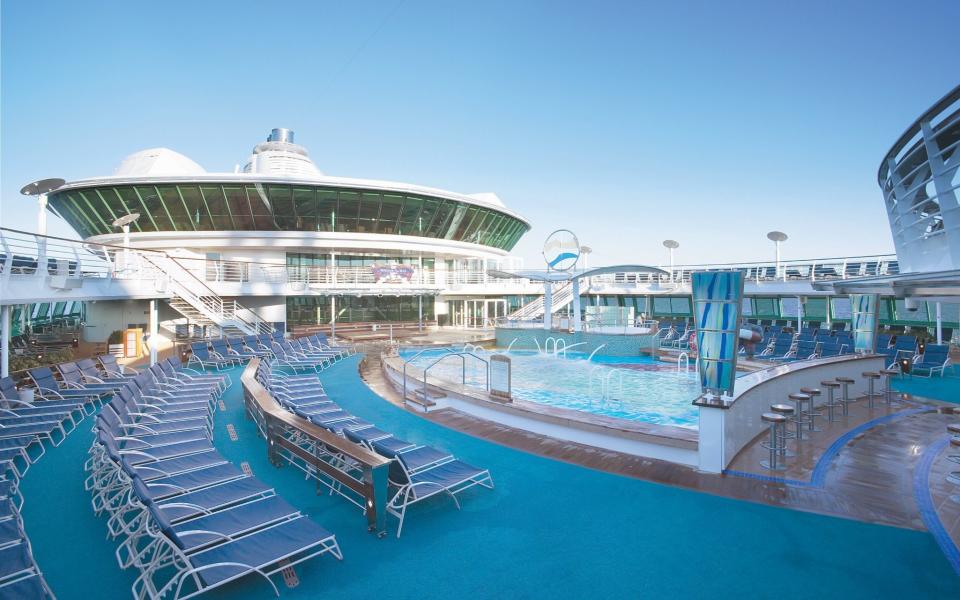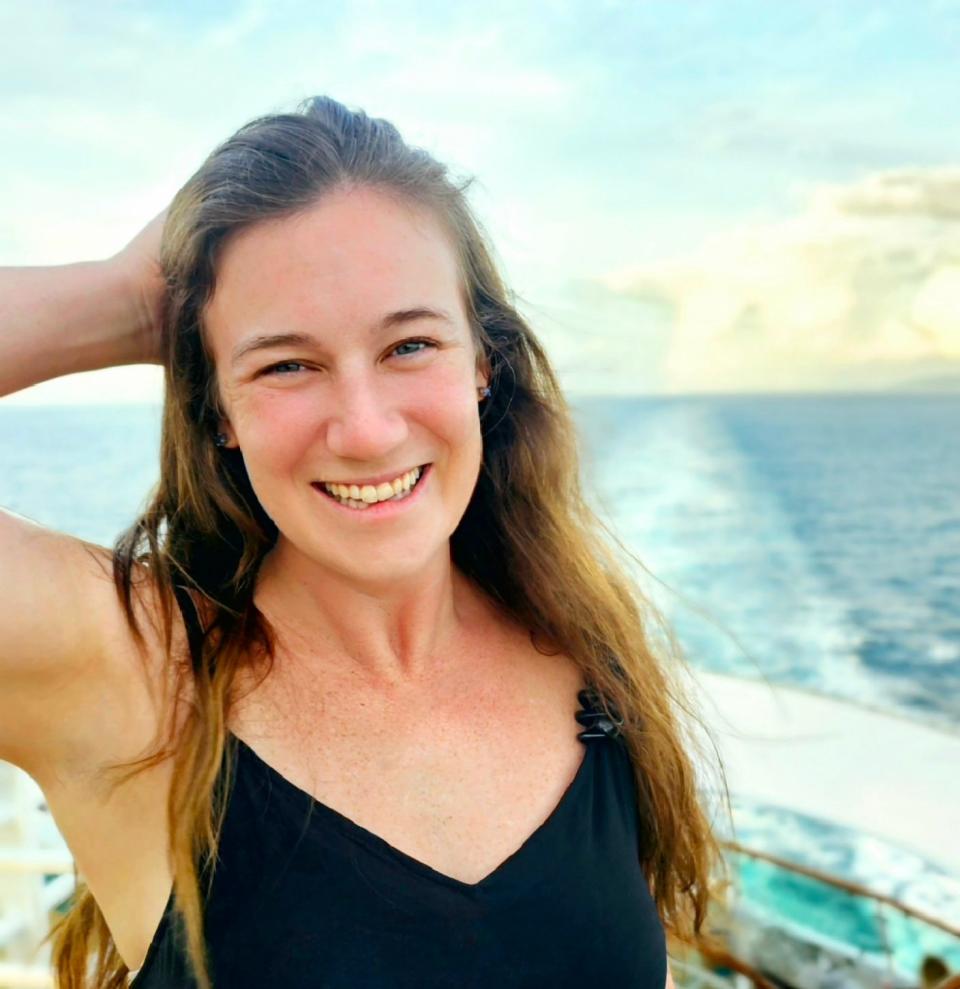Inside the world cruise that went viral

“There’s going to be mutiny, there’s going to be blood, someone is going overboard. I want to watch.”
This isn’t a teaser from some Hollywood thriller, but the opening to a video shared on TikTok about a cruise. Royal Caribbean’s Ultimate World Cruise, to be precise, a round-the-globe odyssey that has become an unlikely online obsession. Since it first left port in November, videos about the journey have been viewed millions of times by a growing cult following.
The scale of the journey is impressive. Over the course of nine months, 27,000 passengers will visit more than 60 countries across all seven continents. There are four main sections of the cruise – the Americas, Asia Pacific, the Middle East and Europe – split into 17 legs. Passengers can opt in to join for one of the sections, mix and match the 17 legs, or stay for the duration. Those who signed up for the full shebang will have parted with between $60,000 (£47,286) and $118,000 (£92,996).
The cruise’s sheer length and cost have made it a curious phenomenon. Yes, world cruises are nothing new – the very first left New York in 1922 – but this one has floated to the top of social media algorithms like a benign iceberg, lurking, unavoidably, on people’s feeds, regardless of any previous interest in cruising.
In fact, that lack of interest might be the point. While the nuts and bolts of cruising are unlikely to thrill, the potential for close-quarters conflict – with nowhere to escape – gives it all a reality TV edge. There’s risk involved, too, and not just from storms and seasickness. Last year, a Cincinnati native was in the headlines after selling her home for a world cruise that was subsequently cancelled. Surely the Royal Caribbean voyage would be packed with drama?

Something of a microindustry has sprung up to document the journey. There are passengers posting daily updates to TikTok and Instagram, chronicling life at sea. But there are also dry-land commentators offering analysis. One is diligently ticking off items on a world cruise bingo card, hoping for a Covid outbreak or shock pregnancy.
A month in, the much-vaunted chaos has amounted to buffet-side impoliteness and false claims of swinging – but people are still hoping for histrionics.
Amike Oosthuizen, a South African influencer, is not surprised by the online interest. She and her family have been booked onto the cruise since 2021. “I’ve always wanted to travel the world,” she says. “And the cruise is a great way to do it, because you have your cabin, you have your own space, and you don’t have to fly between destinations. People want to see your routine, how you live for nine months.”
Her favourite stop so far has been Antarctica – which she says was “magical” – and she’s complimentary of the conditions on board.
“I think there are some [social media content] creators over-exaggerating things,” she says. “And others – ones that are not even on the ship – are using this opportunity to grow their accounts by creating fake drama.”
Amike might not have encountered anything dramatic, but scores of videos are being posted regardless. Cruise expert Emma Le Teace commented: “People are complaining that others are getting special treatment because they have cruise line loyalty [status]. That might be news to them, but it’s pretty normal in the cruise world.
“Are they treating those without loyalty as second-class citizens? I don’t think so, but people in the videos seem very surprised.”

For at least some of the at-home viewers, the “reality show” aspect has prioritised passengers over place. But the human melodrama has diminished somewhat in the face of the natural world. Only a few weeks in, the cruise sailed through Drake Passage, a waterway between Antarctica and Chile subject to notoriously tumultuous conditions. Videos posted online showed the ship surging through the choppy waters.
There was some suggestion that the “show” could end early, too. Rumours surfaced online that, due to the ongoing threat to shipping in the Red Sea, the full itinerary would not be possible. Some ships, like those operated by Viking Cruises, have altered their port calls, and the Ultimate World Cruise is hoping to push on.
Still, the online audience remains rapt – possibly because of the changing nature of the “cast”, which alters with each part of the itinerary. A recent favourite is TikToker Marc Sebastien, who was sponsored by a division of publishing house Simon & Schuster, to join for an 18-day stretch.
Clips posted to his TikTok account show cross-cabin “alliances” and onboard hijinks, including one video in which he “steals” a piece of Antarctic ice. In another, he complains of “non-stop music being pumped into every room, every hall, every dining room that you enter”. Along with other creators, he’s also detailed the number of missed ports and unplanned sea days – an insight one typically does not get from promotional material.
He has also seemingly been scolded for “bad behaviour” on the ship, appearing to be reprimanded for being late for a restaurant booking. In another, he is removed from a private lounge while making a live video, while later being summoned to guest services, or “the principal’s office”.
The phenomenon has certainly showcased holidays at sea to a new audience. Typical cruise passengers are in their 50s or 60s. Most TikTok creators are between 18 and 34. Furthermore, with its steep ticket prices and lengthy time commitments, world cruises are typically beyond the reach of younger demographics.
Also among those posting videos are onboard staff, as well as a couple who have boasted of spending their children’s inheritance. Then there are people like Jenny Hunnicutt, who works remotely and travels full-time.

“This cruise was the catalyst for shifting our lives,” says Hunnicutt who, with her husband, booked tickets for the Royal Caribbean voyage two years ago. “We ended up selling everything: our condo, our cars, a lot of our stuff like furniture and clothing. And then we moved into an RV.”
While she is still working remotely, Hunnicutt is now chronicling life on the cruise too.
“Talking about a cruise like this can feel like bragging,” she says. “I never want to convey that. So the fact that we’ve received positive comments means a lot. People are saying they are grateful for letting them live this experience through us.”
Though interest in the cruise may begin to wane, Emma Le Teace believes that the attention will, ultimately, prove beneficial to the industry. Though she has a word of warning for first-timers. “A round-the-world voyage is very much an advanced cruise. Most people have done quite a few before they do a world cruise. I would suggest people start with a seven-night cruise.”
As for the influencers? “I think it will be hard to go back to everyday life,” Amike says. “This is everyday life now.”


